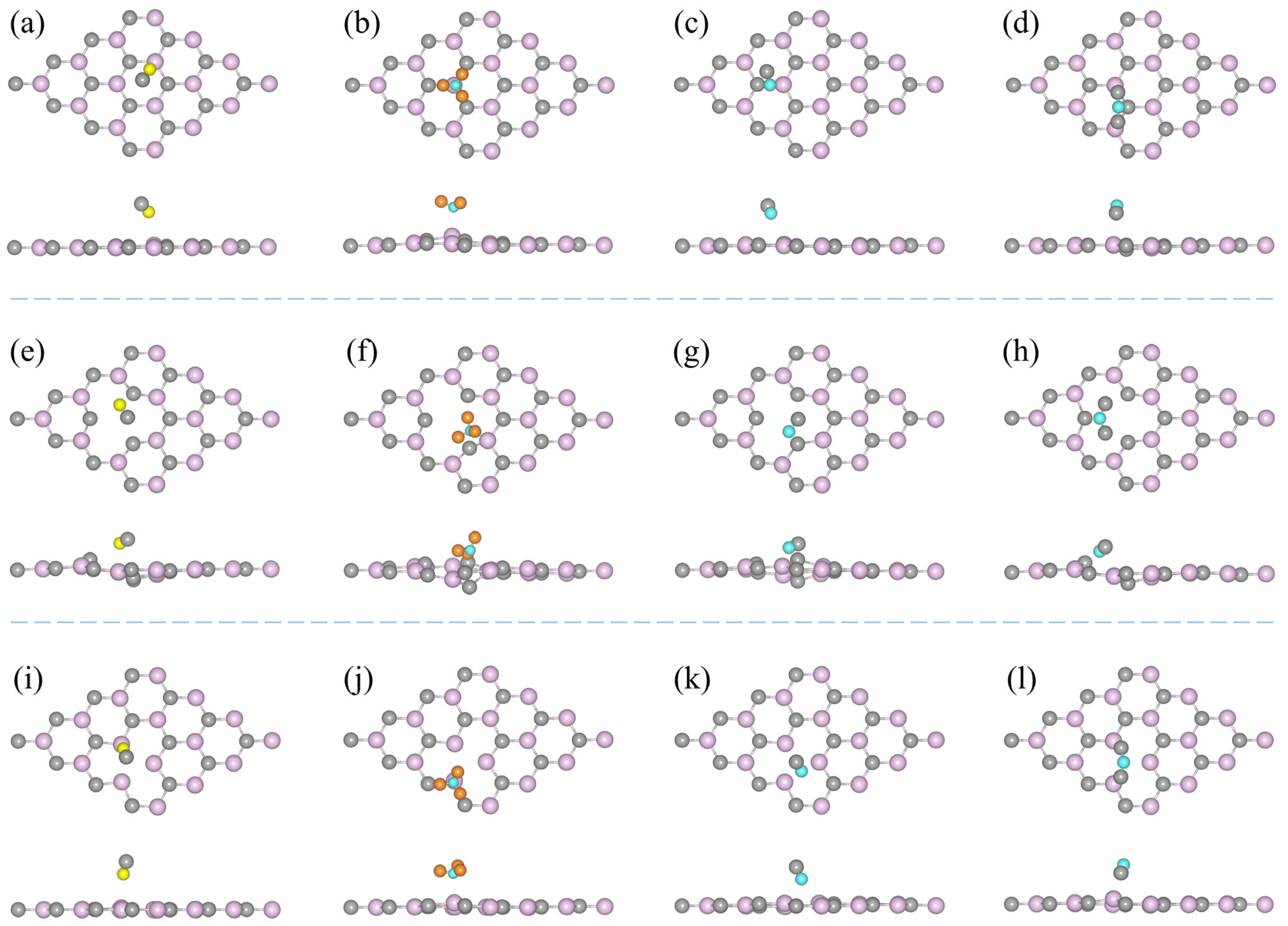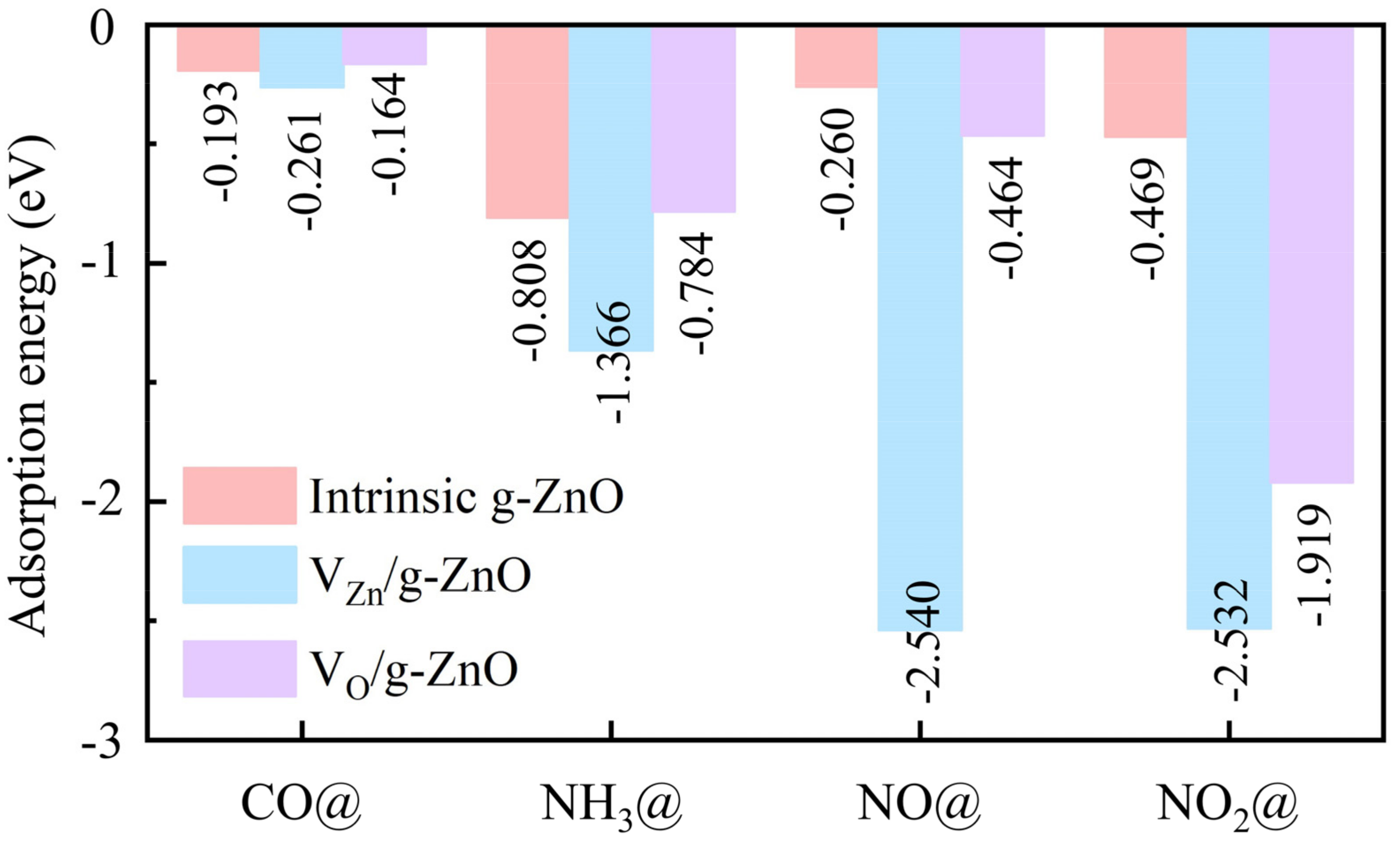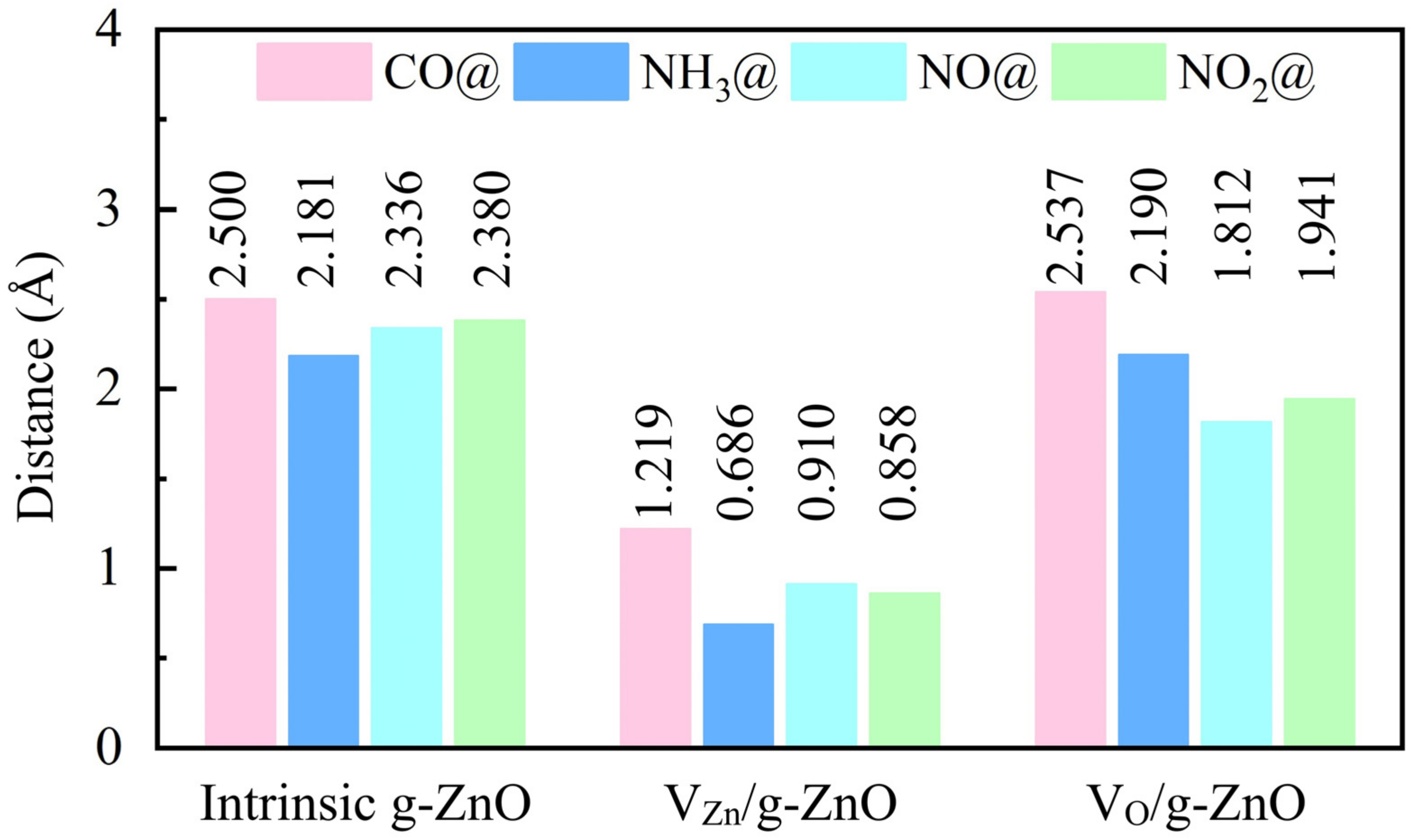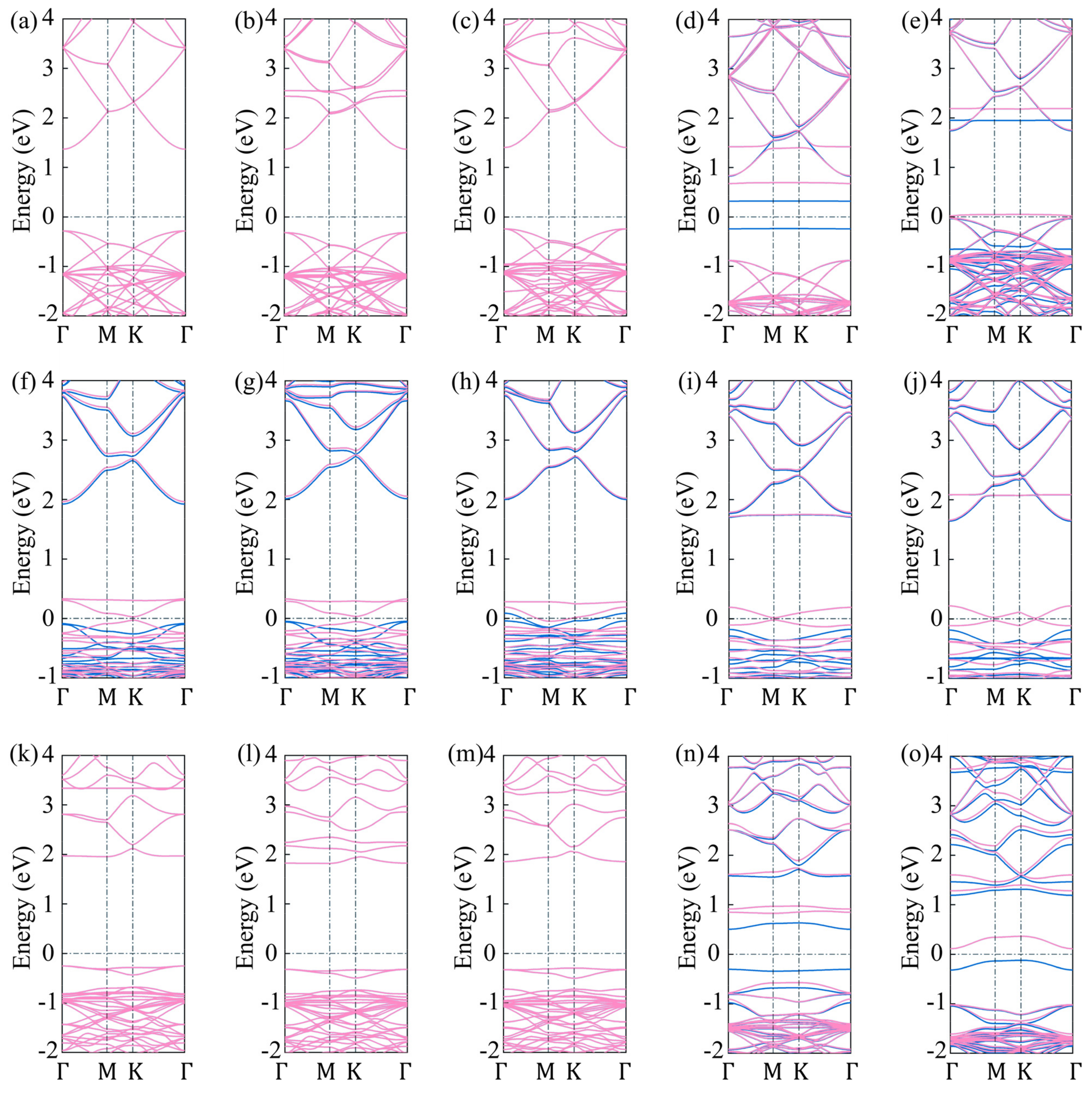Effects of Vacancy Defects and the Adsorption of Toxic Gas Molecules on Electronic, Magnetic, and Adsorptive Properties of g−ZnO: A First-Principles Study
Abstract
1. Introduction
2. Computation Methods and Models
3. Results and Discussion
3.1. Structure and Adsorption Characteristics
3.2. Electronic Characteristics
3.3. Magnetism
4. Conclusions
Author Contributions
Funding
Institutional Review Board Statement
Informed Consent Statement
Data Availability Statement
Conflicts of Interest
References
- Barik, S.; Srivastava, A.; Misra, P.; Nandedkar, R.; Kukreja, L. Alumina capped ZnO quantum dots multilayer grown by pulsed laser deposition. Solid State Commun. 2003, 127, 463–467. [Google Scholar] [CrossRef]
- Wang, Z.L. Nanostructures of zinc oxide. Mater. Today 2004, 7, 26–33. [Google Scholar] [CrossRef]
- Fouad, O.; Ismail, A.; Zaki, Z.; Mohamed, R. Zinc oxide thin films prepared by thermal evaporation deposition and its photocatalytic activity. Appl. Catal. B Environ. 2006, 62, 144–149. [Google Scholar] [CrossRef]
- Cui, Z.; Wang, X.; Li, M.; Zheng, J.; Ding, Y.; Liu, T. Tuning the optoelectronic properties of graphene-like GaN via adsorption for enhanced optoelectronic applications. Solid State Commun. 2019, 296, 26–31. [Google Scholar] [CrossRef]
- Meng, R.; Lu, X.; Ingebrandt, S.; Chen, X. Adsorption of Gas Molecules on Graphene-Like ZnO Nanosheets: The Roles of Gas Concentration, Layer Number, and Heterolayer. Adv. Mater. Interface 2017, 4, 1700647. [Google Scholar] [CrossRef]
- Shen, Y.; Yuan, Z.; Cui, Z.; Ma, D.; Yang, K.; Dong, Y.; Wang, F.; Du, A.; Li, E. Electronic, Magnetic, and Optical Properties of Metal Adsorbed g−ZnO Systems. Front. Chem. 2022, 10, 943902. [Google Scholar] [CrossRef]
- Long, H.; Fang, G.; Li, S.; Mo, X.; Wang, H.; Huang, H.; Jiang, Q.; Wang, J.; Zhao, X. A ZnO/ZnMgO multiple-quantum-well ultraviolet random laser diode. IEEE Electron. Device Lett. 2010, 32, 54–56. [Google Scholar] [CrossRef]
- Tusche, C.; Meyerheim, H.; Kirschner, J. Observation of depolarized ZnO (0001) monolayers: Formation of unreconstructed planar sheets. Phys. Rev. Lett. 2007, 99, 026102. [Google Scholar] [CrossRef]
- Cui, Z.; Ren, K.; Zhao, Y.; Wang, X.; Shu, H.; Yu, J.; Tang, W.; Sun, M. Electronic and optical properties of van der Waals heterostructures of g-GaN and transition metal dichalcogenides. Appl. Surf. Sci. 2019, 492, 513–519. [Google Scholar] [CrossRef]
- Liu, J.; Gao, F.; Wu, L.; Zhang, H.; Hong, W.; Jin, G.; Zhai, Z.; Fu, C. Size effect on oxygen vacancy formation and gaseous adsorption in ZnO nanocrystallites for gas sensors: A first principle calculation study. Appl. Phys. A 2020, 126, 454. [Google Scholar] [CrossRef]
- Sun, M.; Schwingenschlögl, U. δ-CS: A direct-band-gap semiconductor combining auxeticity, ferroelasticity, and potential for high-efficiency solar cells. Phys. Rev. Appl. 2020, 14, 044015. [Google Scholar] [CrossRef]
- Cao, H.; Zhao, Y.; Ho, S.; Seelig, E.; Wang, Q.; Chang, R. Random laser action in semiconductor powder. Phys. Rev. Lett. 1999, 82, 2278. [Google Scholar] [CrossRef]
- Sun, M.; Yan, Y.; Schwingenschlogl, U. Beryllene: A promising anode material for Na-and K-ion batteries with ultrafast charge/discharge and high specific capacity. J. Phys. Chem. Lett. 2020, 11, 9051–9056. [Google Scholar] [CrossRef]
- Bai, K.; Cui, Z.; Li, E.; Ding, Y.; Zheng, J.; Liu, C.; Zheng, Y. Electronic and optical characteristics of GaS/g-C3N4 van der Waals heterostructures: Effects of biaxial strain and vertical electric field. Vacuum 2020, 180, 109562. [Google Scholar] [CrossRef]
- Claeyssens, F.; Freeman, C.L.; Allan, N.L.; Sun, Y.; Ashfold, M.N.; Harding, J.H. Growth of ZnO thin films-experiment and theory. J. Mater. Chem. 2005, 15, 139–148. [Google Scholar] [CrossRef]
- Sahoo, T.; Nayak, S.K.; Chelliah, P.; Rath, M.K.; Parida, B. Observations of two-dimensional monolayer zinc oxide. Mater. Res. Bull. 2016, 75, 134–138. [Google Scholar] [CrossRef]
- Altuntasoglu, O.; Matsuda, Y.; Ida, S.; Matsumoto, Y. Syntheses of zinc oxide and zinc hydroxide single nanosheets. Chem. Mater. 2010, 22, 3158–3164. [Google Scholar] [CrossRef]
- Qin, W.; Yuan, Z.; Gao, H.; Zhang, R.; Meng, F. Perovskite-structured LaCoO3 modified ZnO gas sensor and investigation on its gas sensing mechanism by first principle. Sendor. Actuat. B-Cheim. 2021, 341, 130015. [Google Scholar] [CrossRef]
- Shen, Y.; Yuan, Z.; Cheng, F.; Cui, Z.; Ma, D.; Bai, Y.; Zhao, S.; Deng, J.; Li, E. Preparation and characterization of ZnO/graphene/graphene oxide/multi-walled carbon nanotube composite aerogels. Front. Chem. 2022, 10, 992482. [Google Scholar] [CrossRef]
- Shishiyanu, S.T.; Shishiyanu, T.S.; Lupan, O.I. Sensing characteristics of tin-doped ZnO thin films as NO2 gas sensor. Sendor. Actuat. B-Cheim. 2005, 107, 379–386. [Google Scholar] [CrossRef]
- Cui, Z.; Bai, K.; Ding, Y.; Wang, X.; Li, E.; Zheng, J.; Wang, S. Electronic and optical properties of janus MoSSe and ZnO vdWs heterostructures. Superlattices Microstruct. 2020, 140, 106445. [Google Scholar] [CrossRef]
- Wang, S.; Ren, C.; Tian, H.; Yu, J.; Sun, M. MoS2/ZnO van der Waals heterostructure as a high-efficiency water splitting photocatalyst: A first-principles study. Phys. Chem. Chem. Phys. 2018, 20, 13394–13399. [Google Scholar] [CrossRef] [PubMed]
- Shen, Y.; Yuan, Z.; Cui, Z.; Ma, D.; Yuan, P.; Yang, K.; Dong, Y.; Wang, F.; Li, E. The Electronic Properties of g−ZnO Modulated by Organic Molecules Adsorption. Crystals 2022, 12, 882. [Google Scholar] [CrossRef]
- Guo, H.; Zhao, Y.; Lu, N.; Kan, E.; Zeng, X.C.; Wu, X.; Yang, J. Tunable magnetism in a nonmetal-substituted ZnO monolayer: A first-principles study. J. Phys. Chem. C 2012, 116, 11336–11342. [Google Scholar] [CrossRef]
- Cui, Z.; Yang, K.; Shen, Y.; Yuan, Z.; Dong, Y.; Yuan, P.; Li, E. Toxic gas molecules adsorbed on intrinsic and defective WS2: Gas sensing and detection. Appl. Surf. Sci. 2023, 613, 155978. [Google Scholar] [CrossRef]
- Kresse, G.; Furthmüller, J. Efficiency of ab-initio total energy calculations for metals and semiconductors using a plane-wave basis set. Comp. Mater. Sci 1996, 6, 15–50. [Google Scholar] [CrossRef]
- Perdew, J.P.; Burke, K.; Ernzerhof, M. Generalized gradient approximation made simple. Phys. Rev. Lett. 1996, 77, 3865. [Google Scholar] [CrossRef]
- Kresse, G.; Joubert, D. From ultrasoft pseudopotentials to the projector augmented-wave method. Phys. Rev. B 1999, 59, 1758. [Google Scholar] [CrossRef]
- Grimme, S.; Antony, J.; Ehrlich, S.; Krieg, H. A consistent and accurate ab initio parametrization of density functional dispersion correction (DFT-D) for the 94 elements H-Pu. J. Chem. Phys. 2010, 132, 154104. [Google Scholar] [CrossRef]
- Zhang, L.; Cui, Z. Electronic, Magnetic, and Optical Performances of Non-Metals Doped Silicon Carbide. Front. Chem. 2022, 10. [Google Scholar] [CrossRef]
- Zhang, L.; Cui, Z. Theoretical Study on Electronic, Magnetic and Optical Properties of Non-Metal Atoms Adsorbed onto Germanium Carbide. Nanomaterials 2022, 12, 1712. [Google Scholar] [CrossRef]
- Cui, Z.; Wu, H.; Bai, K.; Chen, X.; Li, E.; Shen, Y.; Wang, M. Fabrication of a g-C3N4/MoS2 photocatalyst for enhanced RhB degradation. Phys. E Low-Dimens. Syst. Nanostruct. 2022, 144, 115361. [Google Scholar] [CrossRef]
- Sun, M.; Re Fiorentin, M.; Schwingenschlögl, U.; Palummo, M. Excitons and light-emission in semiconducting MoSi2X4 two-dimensional materials. npj 2D Mater. Appl. 2022, 6, 81. [Google Scholar] [CrossRef]
- Wang, V.; Xu, N.; Liu, J.; Tang, G.; Geng, W.T. VASPKIT: A user-friendly interface facilitating high-throughput computing and analysis using VASP code. Comput. Phys. Commun. 2021, 267, 108033. [Google Scholar] [CrossRef]
- Yang, K.; Cui, Z.; Li, E.; Ma, D.; Shen, Y.; Yuan, Z.; Dong, Y. Tuning electronic behaviors of WS2 by molecular doping. Mater. Today Commun. 2022, 33, 104226. [Google Scholar] [CrossRef]
- Sun, M.; Luo, Y.; Yan, Y.; Schwingenschlögl, U. Ultrahigh Carrier Mobility in the Two-Dimensional Semiconductors B8Si4, B8Ge4, and B8Sn4. Chem. Mater. 2021, 33, 6475–6483. [Google Scholar] [CrossRef]
- Cui, Z.; Luo, Y.; Yu, J.; Xu, Y. Tuning the electronic properties of MoSi2N4 by molecular doping: A first principles investigation. Phys. E Low-Dimens. Syst. Nanostruct. 2021, 134, 114873. [Google Scholar] [CrossRef]
- Cui, Z.; Wang, X.; Ding, Y.; Li, E.; Bai, K.; Zheng, J.; Liu, T. Adsorption of CO, NH3, NO, and NO2 on pristine and defective g-GaN: Improved gas sensing and functionalization. Appl. Surf. Sci. 2020, 530, 147275. [Google Scholar] [CrossRef]
- Cui, Z.; Zhang, S.; Wang, L.; Yang, K. Optoelectronic and magnetic properties of transition metals adsorbed Pd2Se3 monolayer. Micro Nanostruct. 2022, 167, 207260. [Google Scholar] [CrossRef]
- Cui, Z.; Yang, K.; Ren, K.; Zhang, S.; Wang, L. Adsorption of metal atoms on MoSi2N4 monolayer: A first principles study. Mater. Sci. Semicond. Process. 2022, 152, 107072. [Google Scholar] [CrossRef]
- Chen, H.; Qu, Y.; Ding, J.; Fu, H. Adsorption behavior of graphene-like ZnO monolayer with oxygen vacancy defects for NO2: A DFT study. Superlattices Microstruct. 2019, 134, 106223. [Google Scholar] [CrossRef]
- Sun, Y.; Wang, H. The electronic properties of native interstitials in ZnO. Phys. B 2003, 325, 157–163. [Google Scholar] [CrossRef]
- Huang, B.; Zhou, T.; Wu, D.; Zhang, Z.; Li, B. Properties of vacancies and N-doping in monolayer g−ZnO: First-principles calculation and molecular orbital theory analysis. Acta Phys. Sin. 2019, 68, 246301. [Google Scholar] [CrossRef]
- Zhang, Z.; Zhou, T.; Zhao, H.; Wei, X. First-principles calculations of 5d atoms doped hexagonal-AlN sheets: Geometry, magnetic property and the influence of symmetry and symmetry-breaking on the electronic structure. Chin. Physic. B 2013, 23, 016801. [Google Scholar] [CrossRef]
- QingYu, H.; Yong, L.; ChunWang, Z. First-principles study of Al-doped and vacancy on the magnetism of ZnO. Acta Phys. Sin. 2017, 66, 067202. [Google Scholar]
- Safari, F.; Moradinasab, M.; Fathipour, M.; Kosina, H. Adsorption of the NH3, NO, NO2, CO2, and CO gas molecules on blue phosphorene: A first-principles study. Appl. Surf. Sci. 2019, 464, 153–161. [Google Scholar] [CrossRef]
- Li, Q.; Liu, Y.; Chen, D.; Miao, J.; Zhi, X.; Deng, S.; Lin, S.; Jin, H.; Cui, D. Nitrogen Dioxide Gas Sensor Based on Ag-Doped Graphene: A First-Principle Study. Chemosensors 2021, 9, 227. [Google Scholar] [CrossRef]
- Ruccolo, S.; Sattler, W.; Rong, Y.; Parkin, G. Modulation of Zn-C bond lengths induced by ligand architecture in zinc carbatrane compounds. J. Am. Chem. Soc. 2016, 138, 14542–14545. [Google Scholar] [CrossRef]
- Bosi, F.; Andreozzi, G.B.; Hålenius, U.; Skogby, H. Zn-O tetrahedral bond length variations in normal spinel oxides. Am. Mineral. 2011, 96, 594–598. [Google Scholar] [CrossRef]
- Halfen, J.A.; Mahapatra, S.; Wilkinson, E.C.; Kaderli, S.; Young, V.G., Jr.; Que, L., Jr.; Zuberbühler, A.D.; Tolman, W.B. Reversible cleavage and formation of the dioxygen O-O bond within a dicopper complex. Science 1996, 271, 1397–1400. [Google Scholar] [CrossRef]
- Modec, B. Crystal chemistry of zinc quinaldinate complexes with pyridine-based ligands. Crystals 2018, 8, 52. [Google Scholar] [CrossRef]
- Fang, H.; Banjade, H.; Jena, P. Realization of the Zn3+ oxidation state. Nanoscale 2021, 13, 14041–14048. [Google Scholar] [CrossRef]
- Demaison, J.; Császár, A.G. Equilibrium CO bond lengths. J. Mol. Struct. 2012, 1023, 7–14. [Google Scholar] [CrossRef]
- Hu, W.; Li, Z.; Yang, J. Electronic and optical properties of graphene and graphitic ZnO nanocomposite structures. J. Chem. Phys. 2013, 138, 124706. [Google Scholar] [CrossRef]
- Zhou, C.; Yang, W.; Zhu, H. Mechanism of charge transfer and its impacts on Fermi-level pinning for gas molecules adsorbed on monolayer WS2. J. Chem. Phys. 2015, 142, 214704. [Google Scholar] [CrossRef]
- Salih, E.; Ayesh, A.I. First principle study of transition metals codoped MoS2 as a gas sensor for the detection of NO and NO2 gases. Phys. E Low-Dimens. Syst. Nanostruct. 2021, 131, 114736. [Google Scholar] [CrossRef]
- Wang, S.; Yu, J. Magnetic Behaviors of 3d Transition Metal-Doped Silicane: A First-Principle Study. J. Supercond. Novel Magn. 2018, 31, 2789–2795. [Google Scholar] [CrossRef]










| Adsorption System Type | Configuration | Mtotal (μB) | Eg (eV) | ΔQ (e) |
|---|---|---|---|---|
| Intrinsic | CO | 0 | 1.683 | 0.007 |
| NH3 | 0 | 1.645 | −0.111 | |
| NO | 1 | 1.717 | 0.083 | |
| NO2 | 0.858 | 0 | 0.252 | |
| Zn-vacancy | CO | 1.967 | 0.089 | 0.019 |
| NH3 | 1.191 | 0 | −0.110 | |
| NO | 1 | 1.882 | −0.110 | |
| NO2 | 1 | 1.828 | 0.017 | |
| O-vacancy | CO | 0 | 2.140 | 0.012 |
| NH3 | 0 | 2.151 | −0.101 | |
| NO | 1 | 0.808 | 0.312 | |
| NO2 | 1 | 0.233 | 0.626 |
Disclaimer/Publisher’s Note: The statements, opinions and data contained in all publications are solely those of the individual author(s) and contributor(s) and not of MDPI and/or the editor(s). MDPI and/or the editor(s) disclaim responsibility for any injury to people or property resulting from any ideas, methods, instructions or products referred to in the content. |
© 2023 by the authors. Licensee MDPI, Basel, Switzerland. This article is an open access article distributed under the terms and conditions of the Creative Commons Attribution (CC BY) license (https://creativecommons.org/licenses/by/4.0/).
Share and Cite
Shen, Y.; Yuan, Z.; Cui, Z.; Ma, D.; Yuan, P.; Yang, K.; Dong, Y.; Wang, F.; Li, E. Effects of Vacancy Defects and the Adsorption of Toxic Gas Molecules on Electronic, Magnetic, and Adsorptive Properties of g−ZnO: A First-Principles Study. Chemosensors 2023, 11, 38. https://doi.org/10.3390/chemosensors11010038
Shen Y, Yuan Z, Cui Z, Ma D, Yuan P, Yang K, Dong Y, Wang F, Li E. Effects of Vacancy Defects and the Adsorption of Toxic Gas Molecules on Electronic, Magnetic, and Adsorptive Properties of g−ZnO: A First-Principles Study. Chemosensors. 2023; 11(1):38. https://doi.org/10.3390/chemosensors11010038
Chicago/Turabian StyleShen, Yang, Zhihao Yuan, Zhen Cui, Deming Ma, Pei Yuan, Kunqi Yang, Yanbo Dong, Fangping Wang, and Enling Li. 2023. "Effects of Vacancy Defects and the Adsorption of Toxic Gas Molecules on Electronic, Magnetic, and Adsorptive Properties of g−ZnO: A First-Principles Study" Chemosensors 11, no. 1: 38. https://doi.org/10.3390/chemosensors11010038
APA StyleShen, Y., Yuan, Z., Cui, Z., Ma, D., Yuan, P., Yang, K., Dong, Y., Wang, F., & Li, E. (2023). Effects of Vacancy Defects and the Adsorption of Toxic Gas Molecules on Electronic, Magnetic, and Adsorptive Properties of g−ZnO: A First-Principles Study. Chemosensors, 11(1), 38. https://doi.org/10.3390/chemosensors11010038







